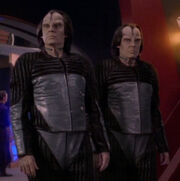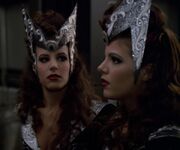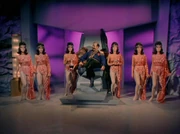No edit summary |
m (lk fix, format fix, POV fix) Tag: sourceedit |
||
| (6 intermediate revisions by 3 users not shown) | |||
| Line 1: | Line 1: | ||
| + | {{at|xx}} |
||
[[File:Miradorn twins.jpg|thumb|The [[Miradorn]] twins [[Ah-Kel]] and [[Ro-Kel]]]] |
[[File:Miradorn twins.jpg|thumb|The [[Miradorn]] twins [[Ah-Kel]] and [[Ro-Kel]]]] |
||
[[File:Jenny and Megan Delaney.jpg|thumb|The [[Human]] [[Delaney sisters]]]] |
[[File:Jenny and Megan Delaney.jpg|thumb|The [[Human]] [[Delaney sisters]]]] |
||
| − | In [[biology]], the term '''multiple births''' refers to multiple [[ |
+ | In [[biology]], the term '''multiple births''' refers to multiple [[siblings]] born during the same [[pregnancy]]. |
The term '''twins''' refers to two siblings born from the same pregnancy. Three siblings born at one time are referred to as '''triplets''', while four are referred to as '''quadruplets'''. These siblings can look alike or different and were often close in age being born only moments apart. |
The term '''twins''' refers to two siblings born from the same pregnancy. Three siblings born at one time are referred to as '''triplets''', while four are referred to as '''quadruplets'''. These siblings can look alike or different and were often close in age being born only moments apart. |
||
| Line 21: | Line 22: | ||
When [[Miles O'Brien|Miles]] and [[Keiko O'Brien]] were considering having [[Kirayoshi O'Brien|their second child]], Miles asked "''What do you say we try for twins...''" Keiko told him that "''I don't think that's the way it works''" and that "''you'd better brush up on your [[biology]].''" ({{DS9|Accession}}) |
When [[Miles O'Brien|Miles]] and [[Keiko O'Brien]] were considering having [[Kirayoshi O'Brien|their second child]], Miles asked "''What do you say we try for twins...''" Keiko told him that "''I don't think that's the way it works''" and that "''you'd better brush up on your [[biology]].''" ({{DS9|Accession}}) |
||
| − | The [[Delaney sisters]] who served aboard {{USS|Voyager}} were |
+ | The [[Delaney sisters]] who served aboard {{USS|Voyager}} were twins. ({{VOY|Time and Again|Prime Factors|Thirty Days|The Disease|Ashes to Ashes}}) |
| − | |||
| − | [[D'Nesh]], [[Maras]], and [[Navarr]] were sisters. ({{ENT|Bound}}) |
||
In the [[20th century]] [[Earth]] [[soap opera]] viewed by [[Neelix]] and [[Kes]], Neelix expressed desire to see if [[Blaine]]'s twin brother was the father of [[Jessica]]'s baby. ({{VOY|Future's End}}) |
In the [[20th century]] [[Earth]] [[soap opera]] viewed by [[Neelix]] and [[Kes]], Neelix expressed desire to see if [[Blaine]]'s twin brother was the father of [[Jessica]]'s baby. ({{VOY|Future's End}}) |
||
| − | [[Clone]]s can often be misidentified as |
+ | [[Clone]]s can often be misidentified as twins, triplets, or even quadruplets . ({{TNG|Up The Long Ladder}}) |
In [[Tom Paris]]' adaption of [[The Doctor]]'s [[holonovel]] ''[[Photons Be Free]]'', where [[Seven of Nine]] was originally envisioned as [[Three of Eight]], became re-envisioned a group of triplets, including one named [[Two of Three]]. ({{VOY|Author, Author}}) |
In [[Tom Paris]]' adaption of [[The Doctor]]'s [[holonovel]] ''[[Photons Be Free]]'', where [[Seven of Nine]] was originally envisioned as [[Three of Eight]], became re-envisioned a group of triplets, including one named [[Two of Three]]. ({{VOY|Author, Author}}) |
||
| − | ''In the [[alternate reality]], |
+ | ''In the [[alternate reality]], {{alt|James T. Kirk}} had an encounter with a pair of [[Caitian]] [[Unnamed Caitians|twins]] in [[2259]]. {{alt|Leonard McCoy}} also mentioned having delivered a set of [[Gorn pregnant female 1|octuplets]] once.'' ({{film|12}}) |
| + | {{bginfo|This event was portrayed in the ''{{dis|Star Trek|video game}}'' game.}} |
||
==See also== |
==See also== |
||
| Line 41: | Line 41: | ||
*[[Twin star]]s |
*[[Twin star]]s |
||
| − | == Background == |
+ | == Background information == |
[[File:Alice series.jpg|thumb|Twins and their false doubles]] |
[[File:Alice series.jpg|thumb|Twins and their false doubles]] |
||
Identical twins were prominently used in casting the episode {{e|I, Mudd}}. The use of these twins for each android "series" aided the photographic-effects budget for the episode. With imaginative use of twins and split screens, as many as six of one model were shown at once, while two of the same model required nothing but an additional costume. This ultimately gave the illusion of a planet of thousands of androids. (''[[The Star Trek Compendium]]'') |
Identical twins were prominently used in casting the episode {{e|I, Mudd}}. The use of these twins for each android "series" aided the photographic-effects budget for the episode. With imaginative use of twins and split screens, as many as six of one model were shown at once, while two of the same model required nothing but an additional costume. This ultimately gave the illusion of a planet of thousands of androids. (''[[The Star Trek Compendium]]'') |
||
Revision as of 13:36, 13 November 2015
AT: "xx"


The Human Delaney sisters
In biology, the term multiple births refers to multiple siblings born during the same pregnancy.
The term twins refers to two siblings born from the same pregnancy. Three siblings born at one time are referred to as triplets, while four are referred to as quadruplets. These siblings can look alike or different and were often close in age being born only moments apart.
Humans were a species that had twins. One example was Artemis who had a twin brother Apollo. (TOS: "Who Mourns for Adonais?")
When Beverly Crusher was eight years old, she had a crush on an older child named Stefan. As her infatuation with him grew, she began to create the imaginary family the two had together in her head, which consisted of them being married and having three children: twin boys, Andrew and Alexander, and then later, a little girl, Jennifer. (TNG: "The Host")
William T. Riker likened meeting his transporter duplicate, Thomas Riker, as being "a little like meeting someone's twin." (TNG: "Second Chances")
Curzon Dax once knew what were described as "gorgeous Ruji twin sisters." (DS9: "A Man Alone")
Benjamin Sisko once mistook Nidell's psychoprojective alter ego, Fenna, as a twin sister. (DS9: "Second Sight")
Twinned Miradorns were not just twin brothers, but together, were a single self: two halves of one being. If one twin died, the other twin would anguish in the loss of self. Ah-Kel and Ro-Kel were an example of a twinning. (DS9: "Vortex")
Vilix'pran began his budding, in 2371, having his first set of twins. (DS9: "Heart of Stone", "Apocalypse Rising")
When Miles and Keiko O'Brien were considering having their second child, Miles asked "What do you say we try for twins..." Keiko told him that "I don't think that's the way it works" and that "you'd better brush up on your biology." (DS9: "Accession")
The Delaney sisters who served aboard USS Voyager were twins. (VOY: "Time and Again", "Prime Factors", "Thirty Days", "The Disease", "Ashes to Ashes")
In the 20th century Earth soap opera viewed by Neelix and Kes, Neelix expressed desire to see if Blaine's twin brother was the father of Jessica's baby. (VOY: "Future's End")
Clones can often be misidentified as twins, triplets, or even quadruplets . (TNG: "Up The Long Ladder")
In Tom Paris' adaption of The Doctor's holonovel Photons Be Free, where Seven of Nine was originally envisioned as Three of Eight, became re-envisioned a group of triplets, including one named Two of Three. (VOY: "Author, Author")
In the alternate reality, James T. Kirk had an encounter with a pair of Caitian twins in 2259. Leonard McCoy also mentioned having delivered a set of octuplets once. (Star Trek Into Darkness)
See also
- Litter
- Siamese twins
- The Twin Mistresses of Evil
- Twin moons
- Twin planets
- Twin stars
Background information

Twins and their false doubles
Identical twins were prominently used in casting the episode "I, Mudd". The use of these twins for each android "series" aided the photographic-effects budget for the episode. With imaginative use of twins and split screens, as many as six of one model were shown at once, while two of the same model required nothing but an additional costume. This ultimately gave the illusion of a planet of thousands of androids. (The Star Trek Compendium)
